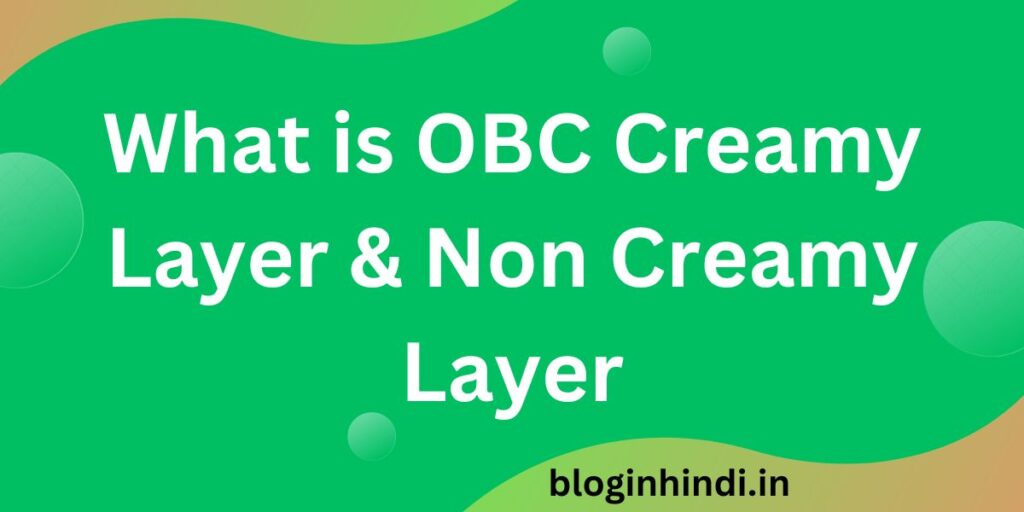Understanding OBC Creamy Layer and Non-Creamy Layer in India
In India, people from various castes and religions reside, and the government has provided reservation based on caste. Under the reservation system, we have categories like SC/ST/OBC, and the OBC category has been further divided by the government into two parts:

What is OBC Creamy Layer and Non-Creamy Layer
What is OBC Creamy Layer?
The term “OBC Creamy Layer” refers to the affluent section of the OBC category who do not require government assistance or reservation benefits. The government has divided the OBC category into two parts to ensure that the extremely backward communities receive proper reservations and support.
Candidates falling under the Creamy Layer are those whose family’s annual income exceeds 8 lakhs. They do not receive the benefit of reservation because, from the government’s perspective, they are considered economically well-off.
What is OBC Non-Creamy Layer?
The term “OBC Non-Creamy Layer” refers to those individuals belonging to the OBC Reserve Category who are eligible for all government services and benefits. Candidates in the OBC Non-Creamy Layer have an annual income of less than 8 lakhs. They receive reservations and other benefits from the government because they are socially and economically disadvantaged.
Key Differences Between OBC Creamy Layer and Non-Creamy Layer
The primary differences between both OBC Layers are as follows:
- Under the Non-Creamy Layer, a candidate’s family’s annual income should not exceed 8 lakhs, while those with an annual income of 8 lakhs or more fall into the Creamy Layer.
- If a candidate’s parents are working in positions lower than Class 3, they are placed in the Non-Creamy Layer. If the parents are employed in positions higher than Class 3, the candidate falls under the Creamy Layer.
This information is crucial for individuals belonging to the OBC category who wish to avail themselves of government schemes. Understanding these distinctions allows them to make the most of their rights and benefits under the reservation system.
Impact of Creamy Layer and Non-Creamy Layer
The categorization of OBCs into Creamy Layer and Non-Creamy Layer has far-reaching implications in the realm of education, employment, and government services. By excluding the economically well-off individuals from reservation benefits, the government aims to channel its resources more effectively towards those who genuinely need support. This ensures that opportunities are distributed equitably, fostering social justice and upward mobility for marginalized communities.
However, it’s essential to periodically review and adjust the income criteria for Creamy Layer and Non-Creamy Layer to account for inflation and changing economic circumstances. Striking the right balance between inclusion and exclusion remains a complex challenge, and policymakers must continually assess the impact of these classifications to ensure that the intended beneficiaries receive the necessary assistance.
Challenges and Debates Surrounding Creamy Layer
The concept of the Creamy Layer within OBC reservations has not been without its share of debates and challenges. Some argue that it might discourage the aspiration for better economic status among OBC communities, as exceeding the income limit could lead to the loss of benefits. Others emphasize that the criteria for Creamy Layer need to be regularly updated to reflect the changing economic landscape.
Furthermore, debates also arise regarding the inclusion or exclusion of specific communities or sub-groups within OBCs from the Creamy Layer definition. Policymakers often grapple with the complexities of these categorizations, aiming to strike a fair balance between promoting social justice and preventing misuse of affirmative action policies.
In conclusion, while Creamy Layer classifications have their share of complexities and controversies, they are an essential part of India’s efforts to promote inclusivity and uplift marginalized communities. Striking the right balance between inclusivity and responsible resource allocation remains a constant challenge, but it is crucial for the nation’s progress towards a more equitable society.
Conclusion
The distinction between OBC Creamy Layer and Non-Creamy Layer plays a pivotal role in India’s affirmative action policies. It embodies the government’s commitment to uplifting underprivileged sections of society while avoiding misuse of reservation benefits. By staying informed about these categories and their implications, individuals can actively engage with government schemes and contribute to the nation’s pursuit of social equity and economic development.
In conclusion, we have explained the concepts of the OBC Creamy Layer and Non-Creamy Layer, along with the key differences between them. We hope this article has provided you with valuable insights, eliminating the need to visit other websites for information.
If you found this article helpful, please share it with your friends and on social media. For more information, visit the official government website of India.
